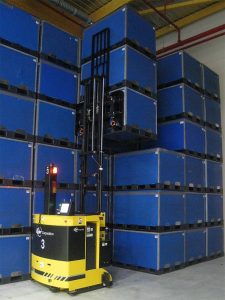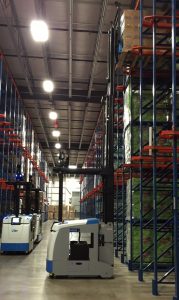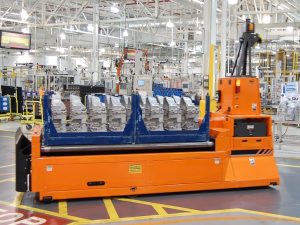The Modern AGV
Guest Blog by Laura McConney, JBT Corporation
Since the mid-1950s, AGVs (automated guided vehicles) have been a mainstay in the materials handling industry. Their ability to increase productivity, reduce labor costs, and improve safety made them no-brainer investments for many facilities working around the clock in order to meet tough deadlines. Initially guided by wires in the floor, which required tedious, disruptive installations, AGVs have gotten a bad rep in today’s fast moving, high tech manufacturing and warehousing centers. But this reputation doesn’t reflect the true capabilities of modern AGVs. These vehicles have evolved with the times. They’re not the same antiquated, cumbersome behemoths that they once were. Now, AGVs are some of the most versatile, technologically sophisticated pieces of material handling equipment on the market, and this shift has been driven customers and applications.
 Today’s manufacturing and warehousing facilities are in the midst of a transformation, one that’s been coined, “Industry 4.0.” But, in all likelihood, if you’re reading the MHI blog (and didn’t just stumble on it through a web search), then you already know the repercussions associated with this shift. Cutting-edge technology. Big Data. The Internet of Things. Automation. The list goes on and on. What all of these buzz words amount to, though, is a new way to approach how things get done in an industrial environment – one in which the customer wants products better and faster, and one in which manufacturers are actually given the tools to meet these demands. When contextualized in the material handling industry, the manufacturers, those who need the equipment that we all sell, require even more from their vendors, including all of us. They want higher throughput, faster delivery, and greater efficiency – all at a lower cost. This puts a significant amount of pressure on material handling equipment providers.
Today’s manufacturing and warehousing facilities are in the midst of a transformation, one that’s been coined, “Industry 4.0.” But, in all likelihood, if you’re reading the MHI blog (and didn’t just stumble on it through a web search), then you already know the repercussions associated with this shift. Cutting-edge technology. Big Data. The Internet of Things. Automation. The list goes on and on. What all of these buzz words amount to, though, is a new way to approach how things get done in an industrial environment – one in which the customer wants products better and faster, and one in which manufacturers are actually given the tools to meet these demands. When contextualized in the material handling industry, the manufacturers, those who need the equipment that we all sell, require even more from their vendors, including all of us. They want higher throughput, faster delivery, and greater efficiency – all at a lower cost. This puts a significant amount of pressure on material handling equipment providers.
Luckily, AGV producers have been in the industry long enough to understand how to meet these challenges. Their collective material handling knowledge, gathered since they began installing systems way back when AGVs first appeared in grocery warehouses, means that they are well suited to deliver what manufacturers desire. For example, in warehouses, AGVs can stack product more than 4 units high. This operation enables manufactures to maximize floor space. Plus, it can occur as a block stack or within racking. The picture to the right provides a good illustration of an AGV performing this maneuver inside a packaging facility.
 Another important capability for vehicles operating in warehouse environments, an AGV’s ability to interface with racking offers manufacturers the same maximization of floor space. Whether the vehicle needs to interact with double-deep, push-back, flow, or drive-in racking, AGVs are up to the task. They can perform virtually any procedure that a manual truck can. The only requirement is repeatability.
Another important capability for vehicles operating in warehouse environments, an AGV’s ability to interface with racking offers manufacturers the same maximization of floor space. Whether the vehicle needs to interact with double-deep, push-back, flow, or drive-in racking, AGVs are up to the task. They can perform virtually any procedure that a manual truck can. The only requirement is repeatability.
Extending beyond the characteristics of forked-style AGVs, the ability to handle multiple loads at once also distinguishes these vehicles from other mobile material handling equipment. Industry 4.0 has put new demands on manufacturers, and as a result, their throughput requirements have skyrocketed. A crucial way to keep up with this increased production rate, the transport of more than one load at a time has become popular in many different vertical industries, such as the beverage, food, and tissue markets. AGVs can approach this problem many different ways. Dual conveyor systems allow several loads to be transferred at once; high-capacity tuggers pull long trains of heavy materials; and various configurations of double fork attachments transport several pallets, sometimes even four at a time.
The versatility of AGVs, which extends beyond even the proficiencies detailed above, proves their worth in the marketplace. While some companies may think that AGVs are “dead” or “old news,” the benefits and capabilities of AGVs are hard to beat. Since their invention in the 1950s, AGV manufacturers have adapted to the times and have incorporated new technology in a knowledgeable and strategic way. They don’t simply adopt the most advanced technology because it’s new and exciting. They do so in order to enhance the product and its applicability in the industry. Today, AGV providers continue to implement cutting-edge technology, develop better algorithms, and improve the scope of what AGVs can accomplish. By using the “latest and greatest” in a thoughtful manner, AGVs meet the challenges that manufacturing and warehousing environments present, and, in all likelihood, will continue to do so in the future.





